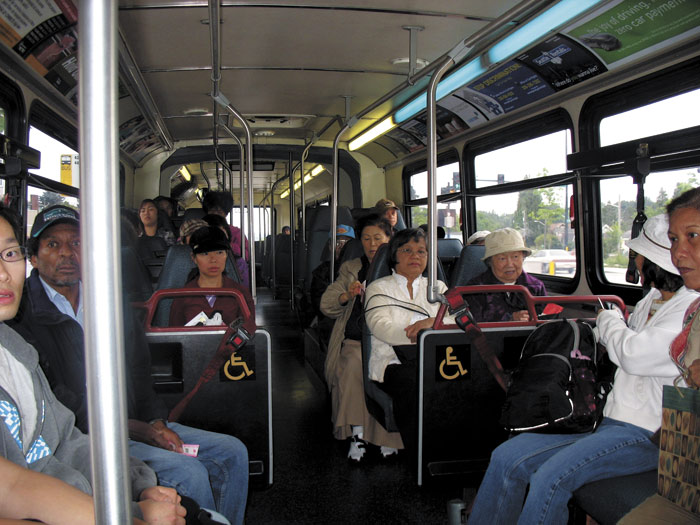One morning last week, the #42 bus, which travels on Martin Luther King Way, was, as usual, full of brown and black faces—a strikingly different picture than the sleek new light-rail trains, which run on the same street. During light rail’s inaugural week, the trains’ passengers were mostly white—pretty surprising given that the trains service the most diverse parts of town.
A ride on the 42 reveals that it’s pretty simple why many of its riders are skipping light rail: The bus is simply more convenient, especially for folks who aren’t traveling to jobs downtown. Lo Ching, for instance, was on his way to a landscaping job in Ballard. He planned to take the 42 downtown, then transfer to the 15.
For Inja Kim and David Shing—ages 74 and 86, respectively—it’s a matter of the distance from their homes to the nearest light-rail station. “It’s hard for an old man like me [to walk far],” says Shing, who adds that he lives about a half-mile away from the Othello station.
However, some of the people on the bus had tried the trains and liked them. “They’re easy, quick, efficient,” says 25-year-old King County employee Chris Frank. Living near the Othello light-rail station, he says he would often take the trains—unless the bus came first, as it had on this day. Other regular riders are obviously passing up the 42 in favor of light rail. The bus had lots of empty seats, stopped less frequently, and arrived downtown five or 10 minutes earlier than usual.
Nationwide, light rail is hardly an all-white phenomenon. In St. Louis, whose Metrolink has been running since the early ’90s, minorities account for 52 percent of the ridership, according to a 2008 survey commissioned by the city’s transit authority. While that’s far less than their share of bus ridership (78 percent), it’s roughly consistent with the percentage of minorities in the city’s population as a whole (49 percent).
There, what’s striking is not that minorities aren’t using light rail, but that whites, who rarely travel on buses, are. Al Gonzalez, an engineering-firm president who worked on the 2008 survey, says that cheap parking lots near the stations make it convenient for Caucasians to park and take the trains, particularly to sporting events.
While Seattle’s light-rail system lacks park & rides (except in Tukwila), something similar may be going on. On the train one morning, a number of the predominantly white riders were new mass-transit users. John Bernier, who works for the boutique health firm Qliance, lives near the 36 bus line on Beacon Hill, but says he used to drive to work and pay $11 for parking because the bus was too crowded and unpleasant. “I’d rather get to work calm and refreshed,” he says, adding that the roomy and air-conditioned train allows him to do just that.
Until recently, RealNetworks software developer Adam Krantz commuted from his Normandy Park home by bus. He says that bus, which traveled on State Route 509, is actually faster—”but the train is more frequent.” Another plus: “It’s nice and smooth. It’s easier to work on with a computer.”
Almost every rider had an electronic gadget in hand. Becky Stanley, a volunteer for mayoral candidate Mike McGinn, was using her iPhone to tweet about her ride. She was testing whether it was faster to take the train downtown, after biking from her Seward Park home to the Columbia City station, than it was to bike all the way. The train won. Biking took 50 minutes; she landed at Westlake Center a half-hour after leaving home.








